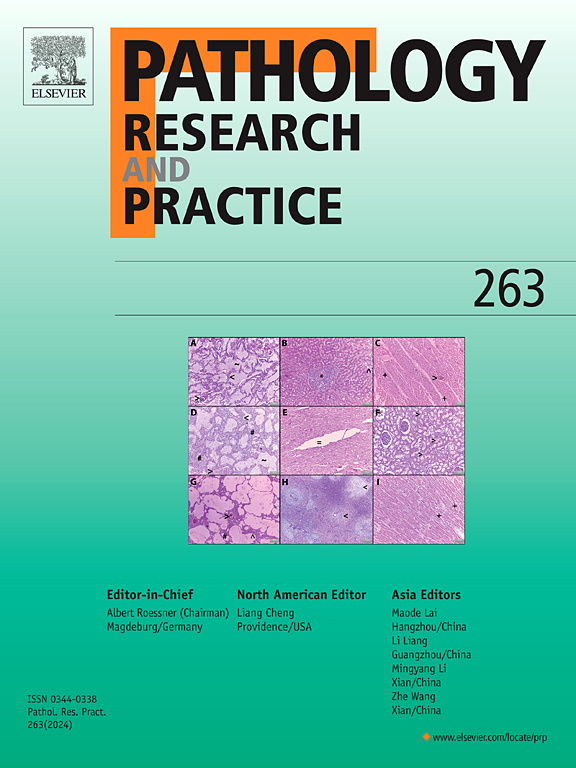茉莉酸甲酯通过调节Caspase-3/COX-2/ NF-κB信号通路减轻顺铂诱导的肾毒性:体内、体外研究
IF 3.2
4区 医学
Q2 PATHOLOGY
引用次数: 0
摘要
顺铂是一种广泛使用的化疗药物;然而,由于几种器官毒性,包括主要通过氧化应激、炎症和细胞凋亡介导的肾毒性,其临床应用受到限制。本研究探讨茉莉酸甲酯(MeJA)通过调节caspase-3/COX-2/NF-κB信号通路减轻顺铂所致肾毒性的保护作用。首先,我们进行了分子对接,以评估MeJA在参比药物氨磷汀存在下与caspase-3、环氧合酶-2 (COX-2)和核因子κB (NF-κB)蛋白的结合亲和力。此外,通过MTT试验、氧化应激和促炎标志物对Madin-Darby犬肾(MDCK)细胞进行体外细胞毒性试验。我们还通过对大鼠肾脏组织的多种生化参数和组织病理学调查,对MeJA对顺铂诱导的实验大鼠肾毒性进行了体内分析。硅分子对接分析显示,MeJA与关键的凋亡和炎症介质之间存在强结合相互作用,表明其可能调节顺铂诱导的毒性。使用MDCK细胞的体外研究表明,MeJA显著降低顺铂诱导的细胞毒性、氧化应激和促炎标志物。大鼠体内实验进一步证实了MeJA的肾保护作用,其肾脏功能指标得到改善,肾小管和肾小球组织得到组织病理学保护。而酶联免疫吸附试验显示,MeJA可下调caspase-3和COX-2的表达,抑制NF-κB的活化。这些发现共同强调了MeJA通过调节细胞凋亡和炎症途径减轻顺铂诱导的肾毒性的治疗潜力。MeJA可能作为一种有前途的肾保护剂,值得进一步的临床研究其在肿瘤环境中的潜在应用。本文章由计算机程序翻译,如有差异,请以英文原文为准。

Methyl jasmonate mitigates cisplatin-induced nephrotoxicity via modulation of Caspase-3/COX-2/ NF-κB signalling pathway: In silico, In vitro, and In vivo investigations
Cisplatin is a widely used chemotherapeutic agent; however, its clinical utility is limited due to several organ toxicities, including nephrotoxicity, which is primarily mediated through oxidative stress, inflammation, and apoptosis. This study examines the protective effect of methyl jasmonate (MeJA) in mitigating cisplatin-induced nephrotoxicity by modulating the caspase-3/COX-2/NF-κB signaling pathway. Initially, we performed molecular docking to evaluate the binding affinity of MeJA against the caspase-3, cyclooxygenase-2 (COX-2), and nuclear factor kappa B (NF-κB) proteins in the presence of the reference drug amifostine. Further, in vitro cell cytotoxicity on Madin-Darby canine kidney (MDCK) cells via MTT assay, oxidative stress, and proinflammatory markers. We have also performed an in vivo analysis of MeJA on cisplatin-induced nephrotoxicity in experimental rats by employing several biochemical parameters and histopathological investigation on rat kidney tissues. In silico molecular docking analysis revealed strong binding interactions between MeJA, key apoptotic and inflammatory mediators, suggesting its potential to regulate cisplatin-induced toxicity. In vitro studies using MDCK cells demonstrated that MeJA significantly reduced cisplatin-induced cytotoxicity, oxidative stress, and proinflammatory markers. In vivo experiments in rats further confirmed the nephroprotective effects of MeJA, as evidenced by improved renal function markers, and histopathological preservation of renal tubules and glomerulus tissues of rat kidneys. While ELISA testing revealed that MeJA downregulates caspase-3 and COX-2 expression and suppresses NF-κB activation. These findings collectively highlight the therapeutic potential of MeJA in alleviating cisplatin-induced nephrotoxicity through modulation of apoptosis and inflammatory pathways. MeJA may serve as a promising nephroprotective agent, warranting further clinical investigation for its potential application in oncology settings.
求助全文
通过发布文献求助,成功后即可免费获取论文全文。
去求助
来源期刊
CiteScore
5.00
自引率
3.60%
发文量
405
审稿时长
24 days
期刊介绍:
Pathology, Research and Practice provides accessible coverage of the most recent developments across the entire field of pathology: Reviews focus on recent progress in pathology, while Comments look at interesting current problems and at hypotheses for future developments in pathology. Original Papers present novel findings on all aspects of general, anatomic and molecular pathology. Rapid Communications inform readers on preliminary findings that may be relevant for further studies and need to be communicated quickly. Teaching Cases look at new aspects or special diagnostic problems of diseases and at case reports relevant for the pathologist''s practice.

 求助内容:
求助内容: 应助结果提醒方式:
应助结果提醒方式:


